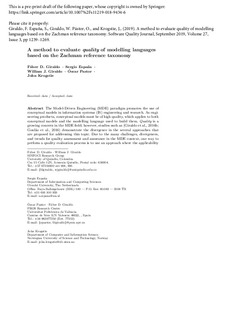| dc.description.abstract | The model-driven engineering (MDE) paradigm promotes the use of conceptual models in information systems (IS) engineering and research. As engineering products, conceptual models must be of high quality, which applies to both conceptual models and the modelling language used to build them. Quality is a growing concern in the MDE field; however, studies such as Giraldo, F.D. et al. Software Quality Journal, pp. 1–66 (2016b) and Goulão, M. et al. Software Quality Journal, pp. 1–33 (2016) demonstrate the divergence in several approaches that are proposed for addressing this topic. Due to the many challenges, divergences, and trends for quality assessment and assurance in the MDE context, one way to perform a quality evaluation process is to use an approach where the applicability and goals of modelling languages (and artifacts) can be compared with respect to the essential principles of the development of IS. We propose using principles from an IS architecture reference (i.e., the Zachman framework) as a taxonomy that is applied on the modelling languages used in information system development in order to perform analytic procedures. We also demonstrate that this taxonomy can be considered as a formal context for the application of the formal concept analysis (FCA) method. This paper derives formal, methodological, and technological requirements for a modelling language quality evaluation method (MMQEF) with the potential to tackle some of the open MDE quality challenges. In addition, a tool that operationalizes the taxonomic evaluation procedure and the FCA analytic method is also presented. In this work, we discuss how this taxonomy supports analytics that are in modelling languages for quality purposes through its management of the semantics. | nb_NO |
